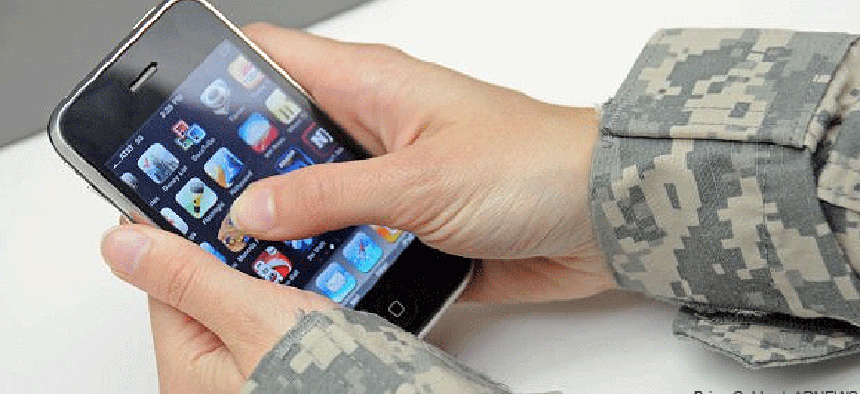DISA opens a path for iOS, Android devices in military


Connecting state and local government leaders
The agency approves security guidelines for Android and iOS operating systems, expanding the range of new devices in a market dominated by BlackBerry.
The recent release of security guidelines for Android and iOS operating systems by the Defense Information Systems Agency opens the way for new devices in a market that has long been dominated by BlackBerry devices.
In announcing the latest Security Technical Implementation Guides (STIGs) for mobile devices, DISA called them a “major stride in building a multi-vendor environment.” They are part of an initiative to get the latest technology into the hands of soldiers, sailors and airmen more quickly.
“We’ve had BlackBerrys forever and they are very good devices,” said Michael McCarthy, operations director of the Army’s Brigade Modernization Command’s Mission Command Complex and also head of the Connecting Soldiers to Digital Applications (CSDA) program. “But there are limits on what they are used for. The fact that we’ve got these now gives us more flexibility on what devices can be used.”
According to DISA, DOD now has about 470,000 BlackBerrys in use, 41,000 mobile devices running Apple iOS and 8,700 running versions of the Android OS.
The new STIGs set out security policy and configuration requirements for government-issued devices using iOS 6 and the hardened Samsung Knox Android operating system. The guidelines do not allow the use of personally owned devices.
Use on DOD systems requires Mobile Device Management systems, which includes management of applications loaded on the device as well as the device itself. DISA is expected to award a contract for the iOS system this summer. Management for the Samsung Knox Android is done through the Fixmo Sentinel Integrity Verification Service.
Sentinel originated as an National Security Agency system for BlackBerry and was licensed to Fixmo through the NSA Technology Transfer Program for commercialization and expansion to other operating systems, including Android.
“There has been a pent-up demand to deploy Android devices in government,” said Tyler Lessard, chief product marketing officer for Fixmo, which helped to develop the Android STIG, along with Samsung and General Dynamics.
The specific configuration and policy requirements are determined by administrators depending on how and by whom a device is used. This is based in part on the vulnerabilities in systems being accessed, which are divided into security categories. The most serious vulnerabilities, Category I, would “directly and immediately result” in a serious breach of confidentiality, availability or integrity of data if exploited. Category II would have the potential for such a breach, and Category III would degrade security controls and measures.
The Samsung Knox (as in Fort Knox) Android is an extension of Android 4.1.1 (Jelly Bean) built on a Security-Enhanced Linux-enabled kernel. It supports North American versions of the Samsung Galaxy S3 and S4 and enables Mobile Device Management. Enhanced security features in the operating system include:
- Mobile application quarantine
- Smart card support
- Host-based firewall
- Ability to revoke mobile application permissions
- Over-the-air audit log retrieval
- Support for PKI authentication and certificate verification in native browser
It also can support multiple user security domains for personal and work use, but the STIG does not yet allow this.
The iOS 6 STIG is for a general-purpose unclassified use of an iOS device, including iPhone 4s, iPad2, iPad Mini, and later iOS devices. The iPod touch is not included because its older processor architecture does not support the trusted iOS boot process available in other devices. “The STIG requires the use of third-party security agents and servers to manage security features on the iOS device,” the requirements say. The requirements are as vendor neutral as possible. “Any compliant third-party product can be used to meet the security requirements.”
Fixmo has announced that its Enterprise Mobility Platform supports the iOS 6 STIG requirements.
The military’s CSDA program aims to create a more agile process for acquiring technology, McCarthy said. Rather than developing requirements for vendors to meet, it deals with what technology is available and how to get it quickly into the hands of soldiers, and then allowing it to be quickly upgraded or replaced as problems are identified and new technology becomes available.
“One of the critical pieces identified that had to be addressed was information assurance,” McCarthy said. Studies found that existing commercial mobile devices could either meet or be modified to meet security requirements for “secret” classification and below at a reasonable cost if properly configured and managed.
The Security Technical Implementation Guides specify proper configuration and management through the operating system. The development of new STIGs speaks to the maturity of the operating systems and their ability to support the necessary security controls.
A STIG for Windows 8 Tablet is in the works, McCarthy said.
“We’re trying to be inclusive, because nobody can tell what will be the best solution five years from now,” he said. “We can’t just stop when we find a solution. We have to continue to search for the best solution that is emerging.”




